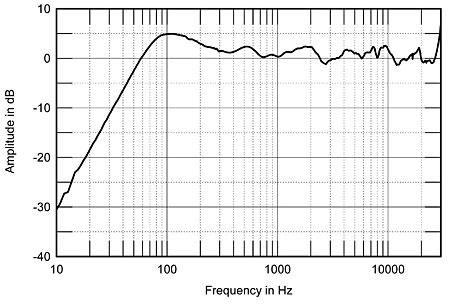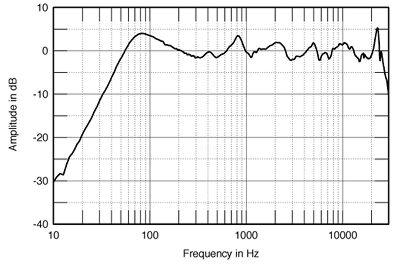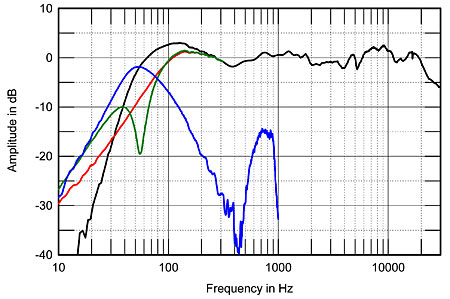Does anyone know if high end audio manufacturers intentionally misalign their vented boxes to give their speakers a more robust sound? I.e. raising fb a little to get a bump in the bass before it rolls off?
I've noticed when I look in Stereophile that the typical well regarded high end speaker has a ~5 db or larger bump in the bass region. For example, the B&W 802D has roughly 7 db of "boom":
http://stereophile.com/images/archivesart/1205802fig4.jpg
I was thinking this could be in part due to Stereophile's measurement technique, but some other speakers they review have no "boom" at all. e.g. Dunlavy SC-IV/A:
http://www.stereophile.com/images/archivesart/D4afig03.jpg
So does anyone know how manufacturers accomplish this bump in the nether region? Do they simply use a woofer that is more efficient than the midrange? Or do they intentionally misalign the woofer? Or is it a combination of both?
I know this is sacrilege, but I've decided I'd like my next set of speakers to have a little extra bass built into the frequency response. When I listen to a speaker with ruler flat response, I find myself reaching for the tone controls....
I've noticed when I look in Stereophile that the typical well regarded high end speaker has a ~5 db or larger bump in the bass region. For example, the B&W 802D has roughly 7 db of "boom":
http://stereophile.com/images/archivesart/1205802fig4.jpg
I was thinking this could be in part due to Stereophile's measurement technique, but some other speakers they review have no "boom" at all. e.g. Dunlavy SC-IV/A:
http://www.stereophile.com/images/archivesart/D4afig03.jpg
So does anyone know how manufacturers accomplish this bump in the nether region? Do they simply use a woofer that is more efficient than the midrange? Or do they intentionally misalign the woofer? Or is it a combination of both?
I know this is sacrilege, but I've decided I'd like my next set of speakers to have a little extra bass built into the frequency response. When I listen to a speaker with ruler flat response, I find myself reaching for the tone controls....
re:'do they intentionally misalign the woofer' - well, I won't point fingers, but it's a perfectly legitimate way to get the kind of reponse you like, although IMHO > 3dB is overkill... You can see how to do it by playing with models in Unibox or Winisd, but a tone control is more easily reversible if you change your mind....
(I get my bass fix by bi-amping & winding up the level on the woofer amp)
(I get my bass fix by bi-amping & winding up the level on the woofer amp)
I know this is sacrilege, but I've decided I'd like my next set of speakers to have a little extra bass built into the frequency response.
Nothing wrong with that. Ever notice how popular the active woofer is these days. No secret there.
Most of the time the measurement bump you see in the speaker measurements is entirely due to measurement error. You CANNOT stitch a nearfield measurement to a farfield measurement and expect to get an accurate representation of the true speaker performance. It is nonsense to do so other than as a comparative technique. Even then, since the degree of error is dependent upon the cabinet size and splicing frequency, the comparison accuracy is limited.
There are ways around this, but they require a clear understanding of the limitations of the various errors introduced by the various measurement systems and techniques, and how the test signals interact with the speaker under test.
Measuring speakers with sufficient accuracy to properly represent the acoustic performance and how that relates to the listening experience is fraught with problems.
The preponderance of computer based measurement systems these days, while of advantage in reducing the cost of entry for making measurements, is a two edged sword. It makes people think that they know how to measure a loudspeaker and how to draw conclusions from these measurements, whereas a lot of the time they are drawings conclusions contaminated by measurement errors.
When there is no measurement bump in the above quoted measurements, it is either because there is no bump, ie the speaker is designed for boundary reinforcement, or the cabinet size is such that the 2pi/4pi transition frequency is above or below the splicing frequency. But you will never know for sure unless you know a lot more about the system under test.
Andrew
There are ways around this, but they require a clear understanding of the limitations of the various errors introduced by the various measurement systems and techniques, and how the test signals interact with the speaker under test.
Measuring speakers with sufficient accuracy to properly represent the acoustic performance and how that relates to the listening experience is fraught with problems.
The preponderance of computer based measurement systems these days, while of advantage in reducing the cost of entry for making measurements, is a two edged sword. It makes people think that they know how to measure a loudspeaker and how to draw conclusions from these measurements, whereas a lot of the time they are drawings conclusions contaminated by measurement errors.
When there is no measurement bump in the above quoted measurements, it is either because there is no bump, ie the speaker is designed for boundary reinforcement, or the cabinet size is such that the 2pi/4pi transition frequency is above or below the splicing frequency. But you will never know for sure unless you know a lot more about the system under test.
Andrew
I'd say most commercial designs would employ the idea. Look at the music most people listen to. Certainly where I'm standing, there's a lot of thuds, and someone singing, with limited talent. People listen to how their tracks are meant to sound, ie, flat response, reasonable volume, and they hate it, because it doesn't hit you in the chest. Doing so is easy enough to do - boost the 50-90Hz region a little and you're there. Most people look for that, so, in order to address the market and sell more products, they put that bump in the response.
Chris
Chris
I think it's important to note that we're not talking about Britney Spears being played through Bose. We're talking about high performance, high dollar loudspeakers made by highly respected companies. If it really sounds so bad then why do these manufacturers do it?
I can't recall anyone ever calling an NHT speaker boomy and yet their speakers have plenty of extra low end (according to stereophile measurements)
Classic Three:

SB-3:

Even Dynaudio is "guilty":

Reading the loudspeaker cookbook (or talking to your average speaker builder) would have you believe that these speakers sound like a Sony Xplod tub of lard. Clearly this is not the case....
I can't recall anyone ever calling an NHT speaker boomy and yet their speakers have plenty of extra low end (according to stereophile measurements)
Classic Three:

SB-3:

Even Dynaudio is "guilty":

Reading the loudspeaker cookbook (or talking to your average speaker builder) would have you believe that these speakers sound like a Sony Xplod tub of lard. Clearly this is not the case....
Most of the time the measurement bump you see in the speaker measurements is entirely due to measurement error. You CANNOT stitch a nearfield measurement to a farfield measurement and expect to get an accurate representation of the true speaker performance. It is nonsense to do so other than as a comparative technique. Even then, since the degree of error is dependent upon the cabinet size and splicing frequency, the comparison accuracy is limited.
There are ways around this, but they require a clear understanding of the limitations of the various errors introduced by the various measurement systems and techniques, and how the test signals interact with the speaker under test.
Measuring speakers with sufficient accuracy to properly represent the acoustic performance and how that relates to the listening experience is fraught with problems.
The preponderance of computer based measurement systems these days, while of advantage in reducing the cost of entry for making measurements, is a two edged sword. It makes people think that they know how to measure a loudspeaker and how to draw conclusions from these measurements, whereas a lot of the time they are drawings conclusions contaminated by measurement errors.
When there is no measurement bump in the above quoted measurements, it is either because there is no bump, ie the speaker is designed for boundary reinforcement, or the cabinet size is such that the 2pi/4pi transition frequency is above or below the splicing frequency. But you will never know for sure unless you know a lot more about the system under test.
Andrew
Sorry, missed this post. So you're essentially saying their measurements are worthless?
There's nothing to say you have to follow the textbook alignments.
In fact none of mine do (even with BSC) and are tweaked to suit my taste, room and partnering equipment. Generally my ports are approximately 0.7 x the Fb calculated length with the raised tuning frequency to give a bump but does it? Read this.
Troelsgravesen vent tuning tests
In fact none of mine do (even with BSC) and are tweaked to suit my taste, room and partnering equipment. Generally my ports are approximately 0.7 x the Fb calculated length with the raised tuning frequency to give a bump but does it? Read this.
Troelsgravesen vent tuning tests
I agree that even well-respected speaker manufacturers do this, though when I asked one why, I was told they would prefer not to, but it was what the market expects!
I find that I simply cannot tolerate any bass-reflex loudspeaker these days, even the high end ones from B&W. (And a lot of sealed boxes sound as if they have Qs over 1.0) Why the market expects a £2000 speaker to sound like some Hoon's sound system in his pimped-up VW Golf is totally beyond me.
<rant>And don't get me on about people who put excessive so-called baffle-step compensation in the speakers either!
</rant>
I find that I simply cannot tolerate any bass-reflex loudspeaker these days, even the high end ones from B&W. (And a lot of sealed boxes sound as if they have Qs over 1.0) Why the market expects a £2000 speaker to sound like some Hoon's sound system in his pimped-up VW Golf is totally beyond me.
<rant>And don't get me on about people who put excessive so-called baffle-step compensation in the speakers either!
</rant>
Does anyone know if high end audio manufacturers intentionally misalign their vented boxes to give their speakers a more robust sound? I.e. raising fb a little to get a bump in the bass before it rolls off?
What i did often is the contrary: Align for smooth rolloff and compensation
of room gain, which is not accounted for in the alignments found by
Thiele and Small. This is also a well known fact and so "misalignments" in
both directions "boomy/smooth rolloff" are quite common.
Since it is practice to modify alignments according to preferences and
room acoustics there is no "misalignment" at all, as long as it is not
overdone.
But i must admit that commercial alignments are often too boomy
in my impression and that causes problems in most listening
environments.
In earlier days i did sometimes "tuning" for commercial speakers bought by
friends, and one measure was often to modify the BR alignment to
more smooth rolloff. Once my "clients" got accustomed to that,
they were happy in most cases.
Best Regards
Last edited:
Nothing wrong with that. Ever notice how popular the active woofer is these days. No secret there.
Its my favorite design.. High Quality sealed MT box with a natural roll off then build bass bins running with high powered amps. Use a DCX to blend it all together and I can have whatever bass I want depending on my mood.
Its all about the "House" curve.
Don't get me wrong, I would rather have a very accurate design then tweak with EQ (Audyssey PRO or DCX2496) in room and I find what B&W does pathetic. I rant about their design flaws all the time with people.
I am with you. I would rather have a system capable of nice even and flat response and then use a good equalizer (digital in my case) to fix what I perceive as the room response and personal preference.
With all the variability of speaker design and response, amplifier design and response, cable impacts, and shaki stones, none of it really is "correct" because it simply can't be. May as well start from a simple baseline and tune from before the analog signal, right?
The 'smooth roll-off + room gain' approach is very much recommended for Tannoy DCs and other low Q drivers.
Tannoy Monitor Gold Crossover: Frequency Response
Tannoy Monitor Gold Crossover: Frequency Response
Here is an (part of)article done by Ingvar Öhman
He is the kind of guy that tests what he thinks and takes note to whatever the result is.
Optimum frequency response curves in the bass range.
He is the kind of guy that tests what he thinks and takes note to whatever the result is.
Optimum frequency response curves in the bass range.
Everyone remember the loudness button?
I have one and use it when listening to low level music.
Its all about the "House" curve.
Don't get me wrong, I would rather have a very accurate design then tweak with EQ (Audyssey PRO or DCX2496) in room and I find what B&W does pathetic. I rant about their design flaws all the time with people.
I have heard a few B&W speakers that sounded very boomy and also exhibited a recessed midrange.
In some cases interactions with the power amplifier's source impedance may also be (partially) to blame if the original designer assumed an amplifier as a perfect voltage source and the amplifier in use actually isn't. (Increases Qe the electrical Q of the woofer and hence QTS and tuning.) Probably not the case with the stereophile measurements however as I expect they would use an amplifier with "ideal" electrical performance for speaker measurements.
I think you could possibly look at this as an underdamped (4th order) butterworth response peaking near the bottom of the usable passband in a typical vented enclosure? (Did I get that right?) Reflexes IMO can interact in interesting ways with the amplifiers (particularly tube) that drive them.
I agree with you guys, it is better to have a loudspeaker with flat response in a properly treated room that is playing a recording that was mixed on a flat system in a properly treated room.
But the fact of the matter is there are still no standards in the audio industry and people tend to buy speakers with a little extra bass.
I guess what I'm really curious about is exactly what manufacturers are doing with their bass, regardless of whether it's a good idea or not. It appears that the stereophile measurements are not perfect, so it's really not clear how most speakers are designed in that regard.
Here's something interesting (albeit outdated) from the loudspeaker design cookbook:
"The results of a survey of US, British and European closed box systems, done in 1969 by professor Richard Small, revealed that most AS speakers fall into 2 categories:
1. cutoff frequency below 50Hz; Qtc up to 1.1; size greater than 1.4 cubic feet.
2. cutoff frequency above 50Hz; Qtc from 1.2 to 2.0; size less than 2 cubic feet.
Category 1 boxes tend to produce good low bass for orchestral and organ music, while category 2 boxes had 'demonstrably stronger bass' with pop electric music"
But the fact of the matter is there are still no standards in the audio industry and people tend to buy speakers with a little extra bass.
I guess what I'm really curious about is exactly what manufacturers are doing with their bass, regardless of whether it's a good idea or not. It appears that the stereophile measurements are not perfect, so it's really not clear how most speakers are designed in that regard.
Here's something interesting (albeit outdated) from the loudspeaker design cookbook:
"The results of a survey of US, British and European closed box systems, done in 1969 by professor Richard Small, revealed that most AS speakers fall into 2 categories:
1. cutoff frequency below 50Hz; Qtc up to 1.1; size greater than 1.4 cubic feet.
2. cutoff frequency above 50Hz; Qtc from 1.2 to 2.0; size less than 2 cubic feet.
Category 1 boxes tend to produce good low bass for orchestral and organ music, while category 2 boxes had 'demonstrably stronger bass' with pop electric music"
- Status
- This old topic is closed. If you want to reopen this topic, contact a moderator using the "Report Post" button.
- Home
- Loudspeakers
- Multi-Way
- Intentional misalignment of vented enclosures: sacriledge?